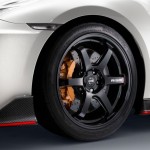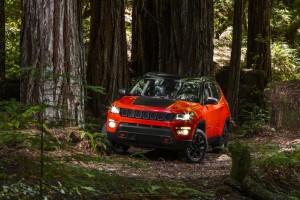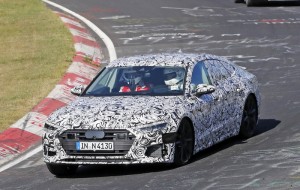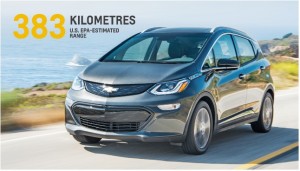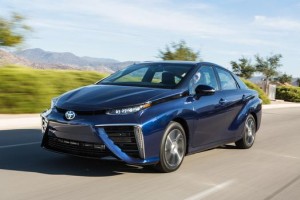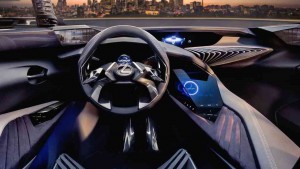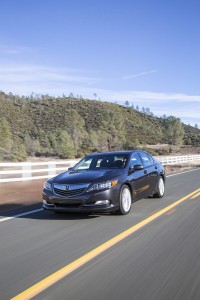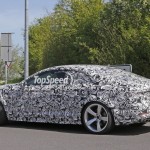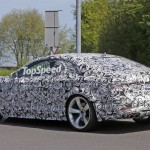Monthly Archives: September 2016
Nissan Releases US Pricing For 2017 GT-R Nismo
Nissan has released a US pricing of $174,990 for the new 2017 GT-R Nismo during its North American debut at the Japanese Classic Car Show at the Queen Mary in Long Beach, California.
The JCCS, an annual gathering, is the largest one of Japanese heritage enthusiasts in the country. It attracts nearly 400 private heritage cars and more than 7,000 spectators.
The GT-R Nismo is now on sale at certified Nissan dealers nationwide. The premium model, on the other hand, started sale early this summer.
The GT-R Nismo is now available for the third straight year, and it continues to deliver supercar dynamics with advanced aerodynamics and precise handling. Nismo, the brand’s motorsport specialists, developed the GT-R Nismo. The model is available in very limited numbers in North America.
The GT-R Nismo for this model year is characterized by a new look inside and out, including driving performance enhancements. The GT-R Premium will be sold for $109,990 while the GT-R Nismo can be bought for $174,990. Destination and handling will be $1,595.
Michael Bunce, vice president for product planning of Nissan North America, said the Nissan GT-R’s performance was “honed, tuned and developed” at the Nürburgring race course last spring.
The 2017 GT-R Nismo has a new “V-motion” grille, which is one of Nissan’s latest design signatures, was enlarged for better engine cooling. It also now features a matte chrome finish, an updated mesh pattern, and a new hood with pronounced character lines that flow from the grille. This same hood was enhanced for high speed driving.
Unique to the Nismo are the carbon fiber front and rear bumpers, black outside mirrors with red stripe, and carbon fiber side sills and emblem. The rear spoiler is made of carbon and has a special coating for the carbon fiber weave style. This material allows for a lightweight feel with strong characteristics.
Jeep Compass Makes Worldwide Debut In Brazil
The Jeep brand introduced the all-new Jeep Compass in Brazil. It was just in time for the celebration of the start of production at FCA’s Jesp Assembly Plant in Goiana, Pernambuco.
The Jeep Compass was launched as a global all-new compact sport utility vehicle. It was produced with 17 fuel-efficient powertrain options for consumers spread across more than 100 countries around the world.
The introduction of the all-new Jeep Compass expands the brand’s global reach, thanks to the combination of features including what is now considered a “legendary” and “best-in-class” 4×4 off-road capability, as well as advanced fuel-efficient powertrains, premium and authentic Jeep design, open-air freedom, superior, on-road driving dynamics, and several safety and advanced technology offers.
But for the US, we are expecting a two-engine mix with either a 1.4-liter turbocharged four-cylinder or a 2.4-liter naturally aspirated four-cylinder as the base motor. The uplevel choice is going to be Jeep’s upcoming 2.0-liter turbocharged Hurricane four-cylinder.
Both the front- and all-wheel drive will be available for the Jeep Compass. The Renegade variant has a manual option while the Cherokee is only available in automatic transmission. For the Compass, there’s no word yet on whether such a transmission will be offered.
On the outside, the Compass looks more like the Grand Cherokee than the Renegade.
This redesigned small crossover was built on the Small Wide platform that was also used for the Fiat 500X and Jeep Renegade. This “trucklet” was meant to fit in between the Tonka-toy Renegade and the landshark-go Cherokee.
This all-new Jeep Compass is being considered as the most capable compact SUV. It will be available in North America in the first quarter of 2017. For additional and more detailed images and information about the Jeep Compass, wait for the vehicle’s North American debut at the Los Angeles Auto Show in November.
Spy Shots Of 2019 Audi S7 Emerge
The second generation Audi S7 was spotted being tested on the road, and it reminds us of the large, four-door hatchback or “Sportback” body found in the Mercedes CLS Coupe, the BMW 6 Series Gran Coupe and the Audi A7 Sportback in 2010.
This is the first time the second-generation Audi S7 was spotted in the wild, so we are sure there will be plenty of surprises in future spy shots. The prototype has a strong resemblance to the Prologue Avant Concept since it has the same stretched-out hexagonal grille and small but dominating corner air intakes.
For now, the fascia is still incomplete, so we’re yet to see if it will sport the proper grille or intake inserts. Up front, you’ll also notice the thin headlights, and this is a big thing because the lower, outer corner of the headlamps on the current S7 dips down. But on this model, the bottom edge of the light is flat while the top edge follows the hood. It is a much cleaner look, and would look great once the camouflage comes off the prototype.
On the sides, the Audi S7 has the same distinct body line on the bottom of the door between the two wheel arches. The mirrors are a little shorter and the rear quarter panels are extended outward, which along with the low body height, gives the vehicle rather a “sitting pretty” look. The roof is very much a true “Sportback” while the sharp body line on the rear quarters fade as it gets closer to the headlights.
There’s a new pair of taillights at the rear end. These are thinner than the current model, and have a more rounded contour on the top and the outside edges. As for the rear fascia, it’s not too different from the current model.
There’s no report yet on the powertrain of the new S7, though it may have the same 4.0-liter V-8, except that a little tweak can power it up to 470 horsepower and 420 pound-feet of torque.
Pricing for the S7 might be $80,500 for the entry model and $85,000 for the prestige.
Chevrolet Released Pricing For 2017 Bolt EV
It looks like Chevrolet is keeping up its promise to offer the 2017 Bolt EV at an affordable price as it recently announced an MSRP of $37,495, including destination charge. This is rather cheap considering the Bolt EV has an EPA-rated 238 miles on a full charge.
Also, depending on individual tax situations, customers may even receive a federal tax credit of up to $7,500 for a net value of $29,995. Alan Batey, president of GM North America and leader of Global Chevrolet, said that “value” is the hallmark for Chevrolet and their offering of an affordable Bolt EV proves their intent of letting their customers access an electric vehicle with plenty of range.
According to reports, Bolt EV buyers can expect range, cargo space, technology and safety features that all come standard in this vehicle with crossover proportions. Bolt EV is considered a smart buy for any customer, thanks to its dependable performance and sales and service support from a nationwide network of Bolt EV certified Chevrolet dealers.
With the Bolt EV, you’re not only saving on fuel and saving the environment at the same time, you’ll also be getting well-appointed equipment and features.
The Bolt EV is offered in the standard but well-equipped LT trim, which has a starting price of $37,495. It comes with a wide array of features such as Regen on Demand™ steering wheel paddle, rear vision camera, 10.2-inch diagonal color touch screen and MICHELIN™ Self-sealing tires (in certain circumstances). The top of the line is the Premier, which features all the equipment in the LT trim plus leather-appointed seats, front and rear heated seats, surround camera and rear camera mirror.
The pricing released includes the destination and freight charges, but excludes taxes, title, license and dealer fees. Select dealerships across the US are expected to start offering the 2017 Bolt EV by late this year.
2017 Toyota Mirai Pricing Officially Revealed
Customers may not be seeing the new Toyota Mirai in showcases anytime soon, but they can expect value pricing for the new model year. For 2017, Toyota is offering competitive and flexible price scheme options for the Mirai. This gives drivers an opportunity to be a part of the automotive industry.
The Mirai hydrogen fuel cell electric vehicle mixes hydrogen and oxygen to create the electricity that powers the vehicle onboard. The car also emits nothing but water vapor, which make it environment friendly and fuel- and power-efficient.
Furthermore, the vehicle has zero emission with an EPA estimated driving range of 312 miles. It refuels in around five minutes too.
The Mirai has an MSRP of $57,500 plus an $865 destination fee. But the good news is that Mirai owners may qualify for an $8,000 federal tax credit and $5,000 potential California rebate, as well as an access to the covered California HOV carpool lane.
Toyota furthered their Mirai trailblazer support program for eligible and qualified customers. The program aims to enhance the purchase and ownership experience by offering it for Lease, which is $349 per month for 36 months with a $2,499 due at signing. It comes with 12,000 per year mileage allowance.
There is the Trailblazer APR Support as well—0% for 60 months or 1.9% for 72 months, and the Trailblazer Purchase Support of $7,500. These charges exclude official fees, taxes and dealer charges.
The 2017 Mirai will bring a new color option called the “Atmospheric Blue” which should complement the existing Celestial Black, Elemental Silver and Nautical Blue Mirai color choices of the model.
The car continues to offer a comprehensive ownership experience, which boasts a range of world class services–three years worth of complimentary fuel, Safety Connect and Entune, three years of 24/7 customer call support, Mirai Complimentary Experience for seven days each year for three years, and standard Toyota Care.
See the Spy Shots And Video Of 2019 Toyota Supra
Back in 2011, Toyota signed a deal with BMW to jointly develop a sports car platform. It then announced a sports car, which would have been based on the platform for a replacement for the Z4. It was termed as the Z5 back then.
Although the Japanese automaker has yet to confirm the Supra name for its upcoming sports car, there were already some hints that it’s soon coming back. In fact, Toyota has reportedly trademarked the Supra name for the European market.
Guys over at SupraMKV released a spy video showing a Supra prototype leaving and entering the BMW M Test Center at the Nüburgring. This isn’t a surprise, of course, since Toyota is developing the Supra together with BMW.
Together with some spy shots, the video revealed that the car is smaller than 2014’s FT-1 concept car, which previously showed the design. Some of the more interesting elements borrowed from that concept are the double-bubble roof, protruding nose, muscular rear fenders, jet fighter-style glasshouse, and ducktail trunk lid. The new liftback can also be clearly seen from the shots.
However, for those excited to see the Toyota Supra, you will have to wait until we’re well into 2018 for it. It will likely arrive as a 2019 model, though it is also possible that a debut will take place in late 2017 at the Tokyo Motor Show.
So far, we know that the new platform has a front-midshap layout and a low center of gravity. That’s clearly evident from the very low hood and roof. It will also feature construction using a multitude of materials–some carbon fiber to keep it lightweight and boost the strength and power.
There should be more than one powertrain option. The range-topper is expected to be a hybrid powertrain combining a twin-turbocharged V-6 with an electric motor or two.
Lexus UX Concept Pioneers 3D Driving Experience
The Lexus UX Concept will make its world debut at the 2016 Paris Motor Show, and it is charged to showcase Lexus’ vision of a compact SUV for the future. The vehicle will apparently represent the company’s new approach in designing and in providing an exceptional driving experience.
The UX concept has a bold and imaginative approach to designing and technologies. It aims to provide customers an immersive driving experience, thanks to the on-board HMI technology that has been designed to offer an “innovative, three-dimensional driver experience.”
The instrument binnacle of the driver has a transparent, hologram-like globe that houses a combination of analog and digital information. The binnacle is both functional and has an unexpected user interface. The center console, on the other hand, features that prominent and faceted crystal structure. Within that, you can find a hologram-style display of air-conditioning and infotainment system that is clearly visible both to the driver and the front passenger.
The new UX concept will also showcase the latest advanced in-vehicle electrical technologies, which include electro-chromatic windows and electrostatic switchgear that is housed under transparent covers. The sideview mirrors have been replaced with e-mirror camera housings. These are far slimmer than the conventional mirror housings on current vehicles.
Drivers may also expect a new audio experience from cars using the UX Concept thanks to the fin motif on the dashboard, the same one that was used on the A pillar. In fact, a removable sound bar was even built into the passenger side of the dashboard, so that everyone can enjoy a one-of-a-kind audio experience.
Stephen Rasmussen, designer at the European Design Centre, ED2, said that the Lexus’ goal is to create a new genre of compact crossover. They want a vehicle that can create an innovative and 3D experience for the user.
Pricing For 2017 Acura RLX Released
The 2017 Acura RLX is the most lavishly equipped and technologically advanced Acura sedan, and it will go on sale tomorrow at Acura dealerships nationwide with a manufacturer’s suggested retail price starting at $54,450.
According to Honda, the Acura sedan offers refined and spirited driving experience, and boasts of standard premium features such as a direct-injected DOHC i-VTEC V-6 engine that contributes to the flagship sedan’s EPA fuel economy ratings of 20/30/232 mpg (city/highway/combined). It can produce 310 horsepower.
The Sport Hybrid RLX model, on the other hand, shares technologies with the Acura NSX like the Super Handling All-Wheel Drive. It will go on sale later this fall. The two-wheel drive RLX will use Acura’s Precision All-Wheel Steer system, which can create a rear-wheel steering affect to sharpen low- and high-speed maneuverability and stability.
All RLX models will come standard with Acura’s Jewel Eye™ LED headlights, 19-inch bright-finished wheels and next generation AcuraLink® connected car system. It also features AcuraWatch™, a comprehensive package of safety and driver assistive technologies that include Collision Mitigation Braking System™ (CMBS), Adaptive Cruise Control (ACC) with Low-Speed Follow (LSF), Forward Collision Warning (FCW), Lane Keeping Assist System (LKAS), Lane Departure Warning (LDW), Blind Spot Information (BSI), Cross Traffic Monitor, and Road Departure Mitigation (RDM).
The AcuraWatch™ is standard to all trims, though the 2017 Acura RLX has two grades—the RLX with Technology Package and RLX with Advanced Package, both of which can deliver advanced performance, comfort and convenience.
To improve the overall ride and handling quality of the sedan, the chassis in the Acura has been redesigned, restructured and has undergone multiple tuning. It will also reportedly reduce vibration, noise and harshness. As for safety rating, it received five stars from NCAP Overall Vehicle because of its next-generation Advanced Compatibility Engineering and seven airbags (including driver’s knee airbag).
The RLX with Technology Package will be sold for $54,450 while the RLX with Advance Package is priced at $60,450.
Spy Shots Of The 2018 Audi RS5 Surface Online
When the A5 and the S5 made their debuts, it became pretty clear how the Audi RS5 will look like. Since there wasn’t an RS5 for the 2016 model year, we’re a bit excited about the styling of the 2018 version.
The next-generation Audi RS5 was caught being tested in the wild, and while it hasn’t shed its camouflage, we can clearly see the correct front fascia and fenders. The vehicle features wider fenders and an RS5-correct front fascia. The fascia looks similar to the model that was caught testing in May, but the new spy shots revealed that the radiator grille is not properly defined in Audi fashion while the corner air intakes were refined to match.
Both the air intakes and the grille don’t have the proper mesh quite yet, though the Audi emblem is now prominently displayed a little below the hood. Now that the correct fascia and fenders are in place, we can safely assume that the RS5 is almost production ready. We may not see in at the Paris Auto Show later this month, but we bet it will debut at the Geneva Auto Show next March.
The rendering of the RS5 coupe showed the same hood as the A5 with the muscular character line and the same headlights. The grille has the same shape, except for the “quattro” lettering that go along with the RS5 emblem on the left side.
The side profile is expected to remain the same, except for a set of larger, light-alloy wheels wrapped in performance-spec tires. Compared to the previous RS5 and to the A5, the body might seat an inch lower to the ground. At the back, it will have the same taillights.
As for the powertrain, the RS5 might be packing a 3.0-liter, turbocharged V-6 that produces somewhere between 450 and 470 horsepower. And since it will be lighter, top speed will likely improve.
The next RS5 is expected to be priced at around $75,000.
US Pricing For 2017 Nissan Altima Announced
Nissan has revealed the US pricing for its 2017 Altima, which is now on sale at Nissan dealers nationwide. It has a starting price of MSRP $22,500. The car is worth the same as the 2016 Altima 2.5 model. The figures released by the company are suggested retail prices, and do not include other fees and charges that the distributor might add.
According to reports, Altima remains to be Nissan’s most popular vehicle, leading sales in 2016 until August of this year. It has distributed 333,000 units last year, and more are expected in the coming months.
The 2017 Nissan Altima has seven models you can choose from. These are the 2.5 ($22,000), 2.5 S ($22,900), 2.5 SR ($24,470), 2.5 SV ($25,460), 2.5 SL ($28,570), 3.5 SR ($27,990), and 3.5 SL ($32,690) models. The five 2.5-liter models can produce a total of 182 horsepower, and has a 2.5-liter DOHC inline 4-cylinder engine. The 3.5-liter models, on the other hand, can offer up to 270 horsepower on its 3.5-liter DOHC V6. All of the 2017 Altima models will come with an advanced Xtronic transmission.
Fuel economy in the 2017 Altima is on a soar again, and this will be evident once reviews come in. It has a standard fuel economy of 39 miles per gallon highway for the Altima 2.5-liter engine equipped models. That’s a full six miles advantage over the leading competitive model in the segment.
The features that are exclusive to the Nissan Altima models are: Predictive Forward Collision Warning, Easy-fill Tire Alert and NASA-inspired Zero Gravity seats. As for safety shield technologies, Nissan is boasting of its Blind Spot Warning and Intelligent Cruise Control to Rear Cross Traffic Alert.
In terms of infotainment system, the new Nissan Altima has 7.0-inch displays, Siri Eyes Free (standard on all except the 2.5), NissanConnectSM with Navigation and Mobile Apps and NissanConnect Services Powered by SiriusXM® telematics (SiriusXM® subscription required, sold separately).










